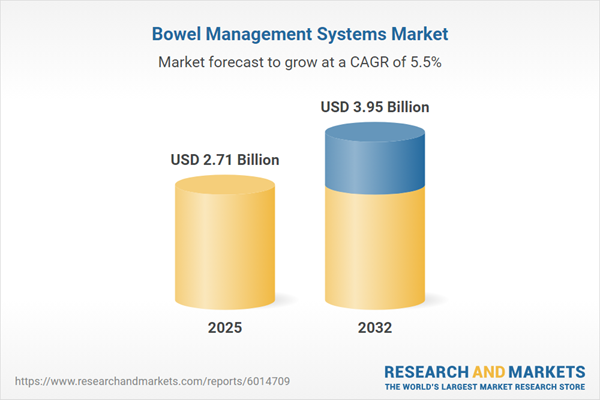Speak directly to the analyst to clarify any post sales queries you may have.
The bowel management systems market is steadily progressing as healthcare organizations seek integrated, efficient solutions to improve patient care and operational workflows. Senior decision-makers recognize the need for actionable insights that enable strategic resource alignment in a complex healthcare landscape.
Bowel Management Systems Market Snapshot
The bowel management systems market continues to expand, supported by growing focus on patient-centric care and ongoing technological innovation. In 2024, the sector reached USD 2.57 billion and is forecasted to rise to USD 2.71 billion in 2025, with projections of USD 3.95 billion by 2032.
Advances in both passive and active bowel management devices now support broader use across hospitals, outpatient facilities, and home care settings. Efforts to streamline workflows and improve device reliability foster safer, more consistent patient outcomes while boosting operational efficiency. These developments contribute to increased adoption of advanced continence care solutions worldwide.Bowel Management Systems Market Scope & Segmentation
- End Users: Hospitals, ambulatory care centers, specialized clinics, outpatient surgical centers, long-term care facilities, nursing homes, assisted living centers, home care providers, professional caregivers, and individuals self-managing care each play a significant role in shaping procurement trends and product development across the market.
- Technology Types: Passive systems, external collection devices, absorbent products, drainage bags, balloon catheters, and electro-stimulating systems address diverse care needs from acute management to chronic support. Each technology supports infection prevention, maximizes patient comfort, and adapts to various health settings where safety, discretion, and workflow integration are priorities.
- Geographic Regions: Distinct regional characteristics influence the market, with the Americas, Europe, Middle East, Africa, and Asia-Pacific presenting unique regulatory requirements, procurement standards, and care delivery protocols that necessitate tailored market approaches and distribution models.
- Corporate Players: B. Braun Melsungen AG, ConvaTec Group plc, Coloplast A/S, Hollister Incorporated, Cardinal Health, Inc., Becton, Dickinson and Company, Baxter International Inc., Medtronic plc, McKesson Corporation, and Wellspect HealthCare AB are pivotal in guiding sector innovation, expanding research activity, and enabling reliable global supply chains.
Bowel Management Systems: Key Takeaways for Senior Decision-Makers
- Interdisciplinary collaboration spanning clinical, operations, and technology departments is critical for successful solution adoption and for aligning investments to the evolving demands of care delivery models.
- Decentralized healthcare models are driving increased adoption of minimally invasive and digitally enabled solutions, such as remote monitoring devices, that support flexible service delivery and wider patient access.
- Rapidly changing reimbursement frameworks and compliance mandates play a central role in influencing purchasing decisions, requiring leaders to regularly assess their procurement and planning approaches to sustain performance.
- Personalized and digital management systems streamline clinical workflows, enhance adherence to standardized protocols, and strengthen satisfaction among care teams and patients by improving usability.
- Ongoing education and targeted training for clinical staff and end users are essential to maintain infection control, drive protocol compliance, and strengthen integration into multiple care settings.
- Supply chain resilience is achieved by aligning product availability with diverse regional regulations, supporting consistent distribution, and enabling organizations to adapt to shifting logistics demands.
Tariff Impact: Navigating Recent Regulatory Shifts
Anticipated United States tariffs in 2025 are prompting companies in the bowel management systems market to reconsider procurement and distribution arrangements. The expectation of higher input costs is motivating organizations to foster resilient relationships with local and regional suppliers. Strategic focus is on maximizing value, aligning with evolving exemption protocols, and investing in regional distribution networks. These measures support ongoing access, control costs, and provide the flexibility to adjust quickly to market changes.
Research Methodology & Data Sources
This analysis utilizes a comprehensive research framework that draws from peer-reviewed clinical literature, firsthand interviews with healthcare professionals, and perspectives from policy experts and end users. This methodology ensures that findings are objective and relevant for strategic business decisions in the bowel management systems sector.
Why This Bowel Management Systems Market Report Matters
- Delivers confidential and actionable market intelligence, supporting executive strategy, resource allocation, and long-term business development.
- Clarifies the evolving landscape of regulations and procurement, equipping leaders to adjust strategies for future market shifts and compliance needs.
- Informs key decisions in investment, product planning, and organizational direction critical to continued success in healthcare technology markets.
Conclusion
This report provides healthcare leaders with the insights needed to refine their strategies and meet changing demands while ensuring effective, comprehensive continence care in diverse care settings.
Additional Product Information:
- Purchase of this report includes 1 year online access with quarterly updates.
- This report can be updated on request. Please contact our Customer Experience team using the Ask a Question widget on our website.
Table of Contents
3. Executive Summary
4. Market Overview
7. Cumulative Impact of Artificial Intelligence 2025
Companies Mentioned
The companies profiled in this Bowel Management Systems market report include:- B. Braun Melsungen AG
- ConvaTec Group PLC
- Coloplast A/S
- Hollister Incorporated
- Cardinal Health, Inc.
- Becton, Dickinson and Company
- Baxter International Inc.
- Medtronic PLC
- McKesson Corporation
- Wellspect HealthCare AB
Table Information
| Report Attribute | Details |
|---|---|
| No. of Pages | 181 |
| Published | November 2025 |
| Forecast Period | 2025 - 2032 |
| Estimated Market Value ( USD | $ 2.71 Billion |
| Forecasted Market Value ( USD | $ 3.95 Billion |
| Compound Annual Growth Rate | 5.5% |
| Regions Covered | Global |
| No. of Companies Mentioned | 11 |









